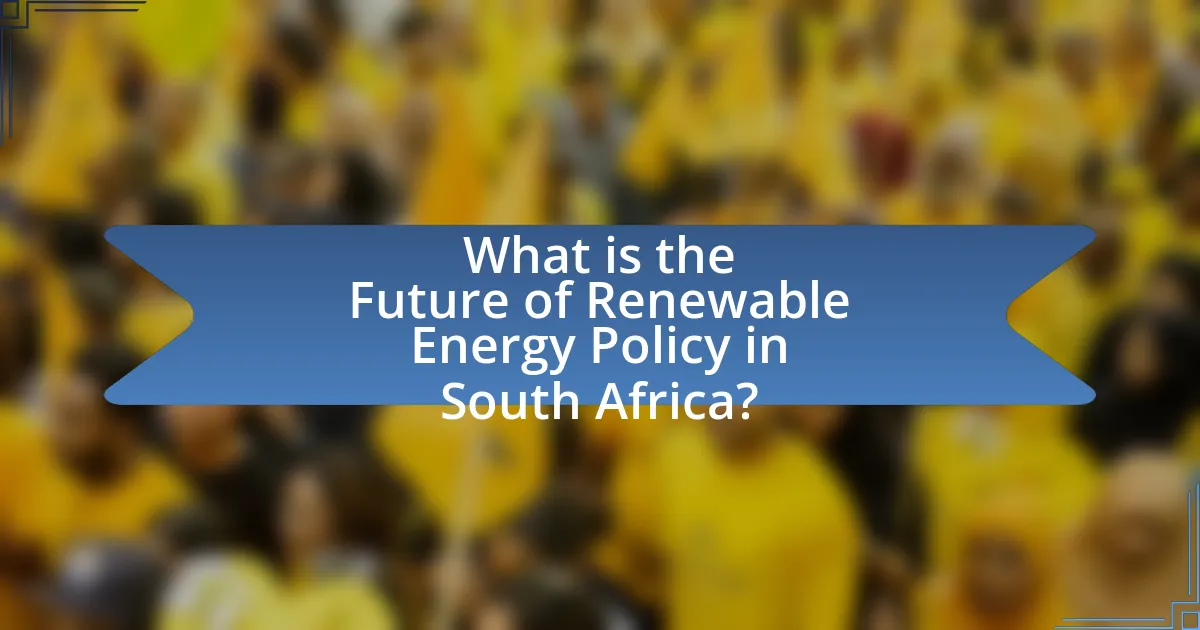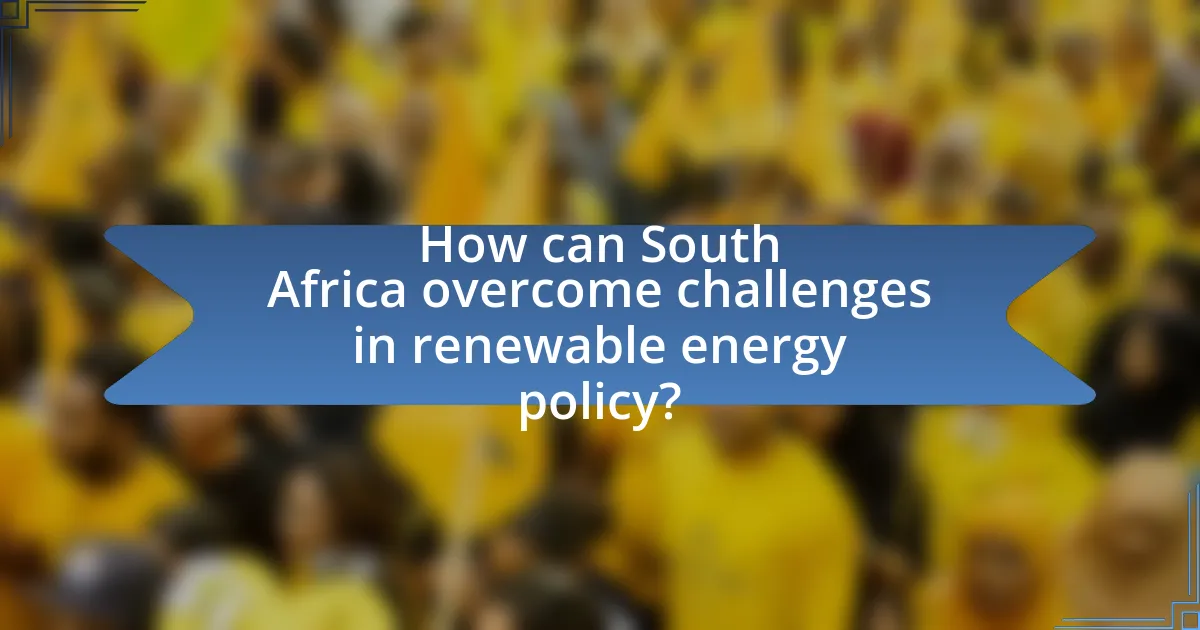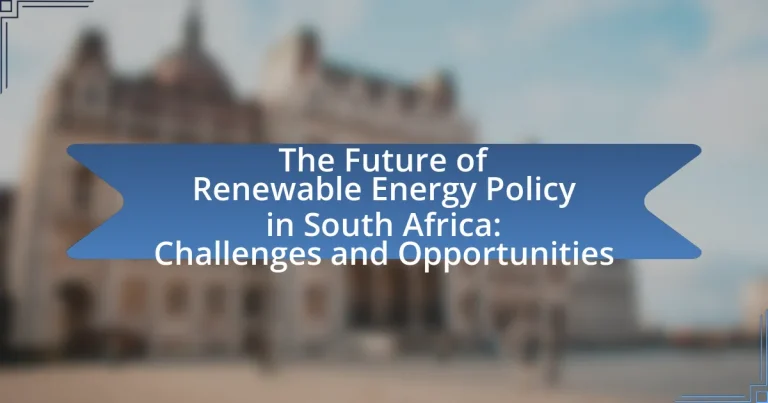The article focuses on the future of renewable energy policy in South Africa, highlighting the government’s commitment to increasing investment in renewable sources, particularly solar and wind energy, to meet energy demands and reduce fossil fuel reliance. Key components of the policy framework include the Integrated Resource Plan (IRP) and the Renewable Energy Independent Power Producer Procurement Programme (REIPPPP), which aim for 18,000 MW of renewable capacity by 2030. The article also addresses challenges such as inadequate infrastructure, regulatory uncertainty, and financing barriers, while exploring opportunities for enhancing policy through public-private partnerships and technological advancements. Additionally, it discusses the economic and environmental benefits of renewable energy, emphasizing its role in job creation and sustainability.

What is the Future of Renewable Energy Policy in South Africa?
The future of renewable energy policy in South Africa is focused on increasing investment in renewable sources, particularly solar and wind energy, to meet the country’s energy demands and reduce reliance on fossil fuels. The South African government aims to achieve a target of 18,000 MW of renewable energy capacity by 2030, as outlined in the Integrated Resource Plan (IRP) 2019. This plan emphasizes the transition to a low-carbon economy and aligns with global climate commitments, including the Paris Agreement. Additionally, the Renewable Energy Independent Power Producer Procurement Programme (REIPPPP) has successfully attracted over R200 billion in private sector investment since its inception, demonstrating the viability and attractiveness of renewable energy projects in the country.
How is renewable energy policy currently structured in South Africa?
Renewable energy policy in South Africa is structured around the Integrated Resource Plan (IRP), which outlines the country’s energy mix and targets for renewable energy generation. The IRP aims to achieve a diversified energy supply, with specific goals set for renewable sources such as wind, solar, and hydroelectric power, targeting 18,000 MW of renewable energy capacity by 2030. Additionally, the Renewable Energy Independent Power Producer Procurement Programme (REIPPPP) facilitates private sector investment in renewable energy projects, promoting competition and cost reduction. This policy framework is supported by legislation such as the Electricity Regulation Act and the National Energy Act, which provide the regulatory environment for energy generation and distribution.
What are the key components of South Africa’s renewable energy policy?
The key components of South Africa’s renewable energy policy include the Integrated Resource Plan (IRP), the Renewable Energy Independent Power Producer Procurement Programme (REIPPPP), and the commitment to reducing greenhouse gas emissions. The IRP outlines the country’s energy mix and sets targets for renewable energy generation, aiming for 18,000 MW of renewable capacity by 2030. The REIPPPP facilitates private sector investment in renewable energy projects, having successfully procured over 6,000 MW of renewable energy since its inception in 2011. Additionally, South Africa’s policy aligns with international climate agreements, such as the Paris Agreement, committing to a 34% reduction in emissions by 2020 and a 42% reduction by 2025, thereby reinforcing its dedication to sustainable energy development.
How does the current policy framework support renewable energy initiatives?
The current policy framework in South Africa supports renewable energy initiatives through various mechanisms such as the Renewable Energy Independent Power Producer Procurement Programme (REIPPPP), which has successfully attracted significant private investment. This program has led to the procurement of over 6,000 MW of renewable energy capacity since its inception in 2011, demonstrating the effectiveness of government policies in facilitating the growth of the renewable sector. Additionally, the Integrated Resource Plan (IRP) outlines specific targets for renewable energy generation, aiming for 18,000 MW of renewable capacity by 2030, further solidifying the government’s commitment to transitioning to a low-carbon economy.
What are the main challenges facing renewable energy policy in South Africa?
The main challenges facing renewable energy policy in South Africa include inadequate infrastructure, regulatory uncertainty, and financial constraints. Inadequate infrastructure hampers the integration of renewable energy sources into the national grid, limiting their effectiveness. Regulatory uncertainty arises from inconsistent policies and lack of long-term planning, which discourages investment in renewable projects. Financial constraints are evident as many renewable energy initiatives struggle to secure funding due to perceived risks and high initial costs. These challenges hinder the transition to a sustainable energy future in South Africa.
Why is financing a significant barrier to renewable energy development?
Financing is a significant barrier to renewable energy development due to the high upfront capital costs associated with renewable projects. These costs can deter investors, as renewable energy technologies often require substantial initial investments before generating returns. For instance, solar and wind projects can demand millions of dollars in capital for installation and infrastructure, which can be challenging to secure, especially in developing regions like South Africa where financial markets may be less mature. Additionally, the perceived risks associated with renewable energy investments, such as regulatory uncertainties and fluctuating energy prices, further complicate financing efforts, leading to a reliance on government support or international funding, which may not always be available.
How do regulatory hurdles impact the growth of renewable energy?
Regulatory hurdles significantly impede the growth of renewable energy by creating barriers to entry and increasing operational costs. In South Africa, complex licensing processes, inconsistent policy frameworks, and lengthy approval timelines deter investment in renewable projects. For instance, the Renewable Energy Independent Power Producer Procurement Programme (REIPPPP) has faced delays due to regulatory uncertainties, which can lead to increased financing costs and project cancellations. According to a report by the International Renewable Energy Agency (IRENA), regulatory challenges can reduce the attractiveness of renewable energy investments, ultimately slowing down the transition to a sustainable energy future.
What opportunities exist for enhancing renewable energy policy in South Africa?
Opportunities for enhancing renewable energy policy in South Africa include increasing investment in renewable technologies, improving regulatory frameworks, and fostering public-private partnerships. The South African government has set a target of generating 20,000 MW of renewable energy by 2030, which presents a significant opportunity for investment and innovation in solar, wind, and biomass energy sectors. Additionally, the Integrated Resource Plan (IRP) outlines a clear pathway for renewable energy integration, allowing for streamlined processes and incentives that can attract both local and international investors. Furthermore, collaboration with private entities can lead to the development of more efficient energy solutions and infrastructure improvements, ultimately supporting the transition to a sustainable energy future.
How can technological advancements improve renewable energy adoption?
Technological advancements can significantly improve renewable energy adoption by enhancing efficiency, reducing costs, and facilitating integration into existing energy systems. For instance, innovations in solar panel technology, such as bifacial panels, have increased energy capture by up to 27% compared to traditional panels, making solar energy more viable. Additionally, advancements in battery storage technology, like lithium-ion batteries, have decreased costs by approximately 89% since 2010, enabling better energy storage solutions that address intermittency issues associated with renewable sources. Furthermore, smart grid technologies allow for improved energy management and distribution, optimizing the use of renewable energy and increasing grid reliability. These advancements collectively contribute to a more sustainable and economically feasible transition to renewable energy sources.
What role do public-private partnerships play in renewable energy development?
Public-private partnerships (PPPs) play a crucial role in renewable energy development by facilitating investment, sharing risks, and enhancing project implementation efficiency. These collaborations leverage the strengths of both sectors; public entities provide regulatory support and infrastructure, while private companies contribute capital, innovation, and operational expertise. For instance, in South Africa, the Renewable Energy Independent Power Producer Procurement Programme (REIPPPP) has successfully attracted over R209 billion in private investment since its inception in 2011, demonstrating the effectiveness of PPPs in mobilizing resources for renewable energy projects. This model not only accelerates the deployment of renewable technologies but also fosters job creation and economic growth, aligning with national energy goals.

How can South Africa overcome challenges in renewable energy policy?
South Africa can overcome challenges in renewable energy policy by implementing a comprehensive regulatory framework that encourages investment and innovation. This framework should include clear guidelines for renewable energy projects, streamlined permitting processes, and financial incentives such as tax breaks or subsidies for both developers and consumers. For instance, the Renewable Energy Independent Power Producer Procurement Programme has successfully attracted over 6,000 MW of renewable energy capacity since its inception in 2011, demonstrating the effectiveness of structured policy initiatives. Additionally, enhancing grid infrastructure and integrating energy storage solutions will facilitate the transition to a more resilient and sustainable energy system.
What strategies can be implemented to address financing issues?
To address financing issues in renewable energy policy in South Africa, strategies such as establishing public-private partnerships, creating green bonds, and enhancing access to international funding can be implemented. Public-private partnerships can leverage private sector investment while sharing risks, as seen in successful projects like the Renewable Energy Independent Power Producer Procurement Programme (REIPPPP), which attracted over R200 billion in investments. Green bonds can provide a dedicated funding source for renewable projects, evidenced by the global green bond market reaching $1 trillion in issuance by 2020. Additionally, improving access to international funding through mechanisms like the Green Climate Fund can facilitate investment in renewable energy initiatives, addressing the financial barriers faced by local projects.
How can government incentives attract investment in renewable energy?
Government incentives can attract investment in renewable energy by reducing financial risks and enhancing profitability for investors. These incentives, such as tax credits, grants, and feed-in tariffs, lower the initial capital costs and improve the return on investment for renewable energy projects. For instance, the South African government has implemented the Renewable Energy Independent Power Producer Procurement Programme (REIPPPP), which has successfully attracted over R209 billion in private sector investment since its inception in 2011. This program demonstrates how structured incentives can create a favorable investment climate, leading to increased deployment of renewable energy technologies and contributing to the country’s energy transition goals.
What alternative funding models could be explored?
Alternative funding models that could be explored for renewable energy in South Africa include green bonds, crowdfunding, and public-private partnerships. Green bonds provide a mechanism for raising capital specifically for environmentally friendly projects, allowing investors to support renewable energy initiatives while earning returns. Crowdfunding platforms enable individuals to invest small amounts in renewable energy projects, democratizing access to funding and increasing community engagement. Public-private partnerships leverage both government resources and private sector expertise to finance large-scale renewable energy projects, enhancing efficiency and innovation. These models have been successfully implemented in various countries, demonstrating their potential effectiveness in South Africa’s renewable energy landscape.
How can regulatory frameworks be improved for better policy outcomes?
Regulatory frameworks can be improved for better policy outcomes by enhancing stakeholder engagement and incorporating adaptive management practices. Engaging stakeholders, including local communities, industry experts, and environmental groups, ensures that diverse perspectives are considered, leading to more effective and inclusive policies. Adaptive management practices allow for continuous learning and adjustment of regulations based on real-world outcomes, which is crucial in the rapidly evolving renewable energy sector. For instance, the South African Renewable Energy Independent Power Producer Procurement Programme has shown that iterative feedback and stakeholder involvement can lead to more successful project implementations and better alignment with national energy goals.
What best practices from other countries can be adopted?
Countries like Germany and Denmark have successfully implemented renewable energy policies that South Africa can adopt. Germany’s feed-in tariff system incentivizes renewable energy production by guaranteeing fixed payments for energy fed into the grid, which has led to a significant increase in solar and wind energy capacity. Similarly, Denmark’s commitment to wind energy, supported by government investment and public-private partnerships, has resulted in wind power supplying over 40% of its electricity. These practices demonstrate effective frameworks for increasing renewable energy adoption and can be tailored to South Africa’s unique context to enhance its renewable energy policy.
How can stakeholder engagement enhance policy effectiveness?
Stakeholder engagement enhances policy effectiveness by ensuring that diverse perspectives and expertise are incorporated into the decision-making process. This inclusion leads to more informed policies that address the actual needs and concerns of the community, thereby increasing public support and compliance. For instance, research by the World Resources Institute indicates that policies developed with stakeholder input are 30% more likely to be successfully implemented. Engaging stakeholders also fosters collaboration, which can lead to innovative solutions and shared resources, ultimately improving the overall impact of renewable energy policies in South Africa.
What is the role of renewable energy in South Africa’s economic future?
Renewable energy plays a crucial role in South Africa’s economic future by driving job creation, enhancing energy security, and promoting sustainable development. The South African government aims to increase the share of renewable energy in the national energy mix to 30% by 2030, which is projected to create approximately 400,000 jobs in the renewable sector. Additionally, the transition to renewable energy sources, such as solar and wind, reduces reliance on fossil fuels, thereby improving energy security and decreasing greenhouse gas emissions. This shift not only aligns with global sustainability goals but also attracts foreign investment, further stimulating economic growth.
How does renewable energy contribute to job creation in South Africa?
Renewable energy significantly contributes to job creation in South Africa by fostering new employment opportunities in various sectors such as manufacturing, installation, and maintenance of renewable energy technologies. According to a report by the International Renewable Energy Agency (IRENA), South Africa’s renewable energy sector employed approximately 150,000 people in 2020, with projections indicating that this number could rise to over 300,000 by 2030 as the country expands its renewable energy capacity. This growth is driven by government initiatives, such as the Renewable Energy Independent Power Producer Procurement Programme (REIPPPP), which encourages private investment and development in renewable energy projects, thereby stimulating local economies and creating jobs.
What sectors are most likely to benefit from renewable energy growth?
The sectors most likely to benefit from renewable energy growth include the energy sector, manufacturing, agriculture, and transportation. The energy sector will see increased investment in solar, wind, and hydroelectric projects, which are projected to create jobs and reduce reliance on fossil fuels. Manufacturing will benefit from the demand for renewable energy technologies, such as solar panels and wind turbines, with the global market for these technologies expected to reach $1.5 trillion by 2025. Agriculture can leverage renewable energy for sustainable practices, reducing costs and enhancing productivity through solar-powered irrigation systems. Transportation will shift towards electric vehicles, supported by renewable energy sources, with the electric vehicle market projected to grow significantly, driven by the need for cleaner alternatives.
How can renewable energy support local economies?
Renewable energy can support local economies by creating jobs, stimulating local investment, and reducing energy costs. For instance, the solar and wind sectors have been shown to generate significant employment opportunities; the International Renewable Energy Agency reported that the renewable energy sector employed over 11 million people globally in 2018, with substantial growth expected in emerging markets like South Africa. Additionally, local investments in renewable energy projects can lead to infrastructure development and increased economic activity, as seen in regions where community-owned renewable projects have been implemented. Furthermore, renewable energy can lower energy costs for businesses and households, enhancing economic stability and growth.
What environmental benefits can be expected from renewable energy policy?
Renewable energy policy can significantly reduce greenhouse gas emissions, leading to improved air quality and a decrease in climate change impacts. By transitioning to renewable sources like solar and wind, South Africa can lower its reliance on fossil fuels, which currently contribute to approximately 80% of the country’s carbon emissions. This shift not only mitigates pollution but also promotes biodiversity by reducing habitat destruction associated with fossil fuel extraction. Furthermore, studies indicate that renewable energy systems require less water than traditional energy sources, thus conserving vital water resources in a water-scarce country like South Africa.
How does renewable energy impact carbon emissions in South Africa?
Renewable energy significantly reduces carbon emissions in South Africa by replacing fossil fuels in electricity generation. The country aims to increase its renewable energy capacity, which is projected to decrease carbon dioxide emissions by approximately 42% by 2030, according to the South African government’s Integrated Resource Plan. This transition is crucial as South Africa’s energy sector is one of the largest contributors to greenhouse gas emissions, primarily due to its reliance on coal. By investing in solar, wind, and hydroelectric power, South Africa not only mitigates climate change impacts but also aligns with global sustainability goals.
What are the long-term sustainability benefits of renewable energy adoption?
The long-term sustainability benefits of renewable energy adoption include reduced greenhouse gas emissions, enhanced energy security, and economic growth through job creation. Renewable energy sources, such as solar and wind, produce little to no emissions during operation, significantly lowering the carbon footprint compared to fossil fuels. For instance, a study by the International Renewable Energy Agency (IRENA) indicates that transitioning to renewable energy could reduce global CO2 emissions by up to 70% by 2050. Additionally, renewable energy enhances energy security by diversifying energy sources and reducing dependence on imported fuels, which is crucial for countries like South Africa. Furthermore, the renewable energy sector has the potential to create millions of jobs; the IRENA reported that the renewable energy sector employed over 11 million people globally in 2018, with significant growth expected in the coming years.
What practical steps can be taken to advance renewable energy policy in South Africa?
To advance renewable energy policy in South Africa, the government should implement a comprehensive regulatory framework that encourages investment in renewable technologies. This framework can include clear targets for renewable energy generation, streamlined permitting processes, and financial incentives such as tax breaks or subsidies for renewable energy projects.
For instance, the Integrated Resource Plan (IRP) 2019 outlines a commitment to increase the share of renewables in the energy mix, aiming for 20,000 MW of renewable energy capacity by 2030. Additionally, establishing public-private partnerships can facilitate funding and innovation in the sector, as seen in successful projects like the Renewable Energy Independent Power Producer Procurement Programme (REIPPPP), which has attracted over R200 billion in investment since its inception.
Furthermore, enhancing grid infrastructure to accommodate renewable energy sources and investing in energy storage solutions will ensure reliability and stability in energy supply. These steps collectively create a conducive environment for the growth of renewable energy in South Africa.
How can individuals and communities contribute to renewable energy initiatives?
Individuals and communities can contribute to renewable energy initiatives by adopting sustainable practices such as installing solar panels, participating in community wind projects, and advocating for local renewable energy policies. For instance, a study by the International Renewable Energy Agency (IRENA) indicates that decentralized renewable energy systems can significantly reduce energy costs and enhance energy security in communities. Furthermore, community engagement in renewable energy projects fosters local job creation and economic development, as evidenced by the South African government’s Renewable Energy Independent Power Producer Procurement Programme, which has generated thousands of jobs while promoting clean energy.
What are the best practices for advocating for renewable energy policy changes?
The best practices for advocating for renewable energy policy changes include building a coalition of stakeholders, utilizing data-driven arguments, and engaging in grassroots mobilization. Building a coalition involves uniting various groups such as environmental organizations, businesses, and community leaders to create a unified voice for policy change. Data-driven arguments are essential; for instance, studies show that renewable energy can create jobs and reduce greenhouse gas emissions, making a compelling case for policymakers. Grassroots mobilization engages the public through campaigns and education, increasing awareness and pressure on decision-makers. These practices have been effective in various contexts, as evidenced by successful renewable energy initiatives in countries like Germany and Denmark, where collaborative efforts and public support led to significant policy advancements.


